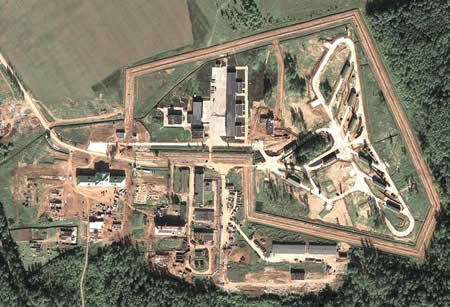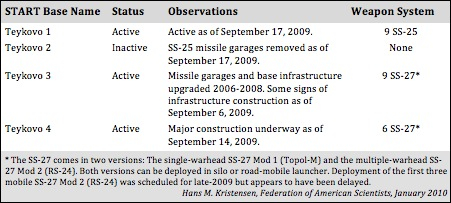 |
| Russia’s Teykovo 4 missile garrison northeast of Moscow is undergoing major upgrades for new SS-27 mobile nuclear missiles. Click image for large illustration of the changes. |
.
By Hans M. Kristensen
The latest overview of Russia’s nuclear forces produced by Robert Norris from NRDC and myself is now available on the website of the Bulletin of the Atomic Scientists.
We estimate that Russia currently (January 2010) deploys approximately 4,600 nuclear weapons, down from roughly 4,800 a year ago. The arsenal includes some 2,600 strategic warheads and about 2,000 warheads for nonstrategic forces. Another 7,300 weapons are thought to be in reserve or awaiting dismantlement for a total inventory of approximately 12,000 nuclear warheads. We estimate the weapons are stored at 48 permanent storage sites.
SS-27 Modernization at Teykovo
One of the interesting developments is Teykovo northeast of Moscow where four missile garrisons are in the process of upgrading from the SS-25 road-mobile intercontinental ballistic missile (ICBM) to the newer SS-27. One base still has SS-25s while the other three are in various stages of upgrading.
The SS-27 comes in two versions: single-warhead SS-27 Mod 1 (Topol-M) and the multiple-warhead SS-27 Mod 2 (RS-24). The two versions can be deployed in silos or on mobile launchers. All Teykovo missiles are mobile. Fifteen SS-27 Mod 1s have already been deployed, and the Russian military stated repeatedly in 2009 that the first SS-27 Mod 2 (RS-24) would become operational at Teykovo by the end of the year, which we wrote in our overview. That apparently did not happen after all and the system is now expected to become operational sometime in early-2010.
Commercial satellite images taken over the past five years clearly show major construction work at the garrisons. The newest images from late-2009 show that two garrisons appear to be active, one is undergoing major upgrades (see image above), and one was inactive as of September 2009.
| Teykovo ICBM Garrison Status 2009 |
 |
| Click table for larger version. |
.
Teykovo 1 (56°48’33.11″N, 40°10’15.89″E) appears to be active with the SS-25. Nine launchers (one regiment) are deployed. A satellite photo from September 17, 2009, shows no construction. The base might be converted to SS-27 in the future.
Teykovo 2 (56°55’0.42″N, 40°18’31.39″E) no longer has operational SS-25s with all missile garages missing in a satellite image from September 17, 2009. No construction has begun but the base might be converted to SS-27 in the future.
Teykovo 3 (56°55’56.98″N, 40°32’38.47″E) appears to have almost completed its upgrade. Major construction occurred in 2006-2008 and some remaining construction is visible in a satellite image from September 6, 2009. Nine SS-27s are operational.
Teykovo 4 (56°42’15.10″N, 40°26’25.29″E) appears to be in the process of upgrading to SS-27, with six of eventually nine launchers apparently operational. Deployment of the first three SS-27 Mod 2 (RS-24) was scheduled for late-2009 but appears to have been delayed to later this year.
Modernization and Fear Mongering
Russian nuclear modernization is a hot topic in Washington with some trying to block new nuclear arms reductions by claiming that the United States is falling behind. That is fortunately far from the truth (see here and here) and the upgrade at Teykovo has been long in the coming and slow.
Like the United States, Russia is reducing its nuclear weapons but also modernizing its remaining forces. How the Kremlin plans to reconcile this modernization with the pledge to pursue nuclear disarmament that president Dmitry Medvedev made with his U.S. counterpart in 2009 will be interesting to see in the years ahead.
This publication was made possible by a grant from Carnegie Corporation of New York and Ploughshares Fund. The statements made and views expressed are solely the responsibility of the author.
While it is reasonable for governments to keep the most sensitive aspects of nuclear policies secret, the rights of their citizens to have access to general knowledge about these issues is equally valid so they may know about the consequences to themselves and their country.
Nearly one year after the Pentagon certified the Sentinel intercontinental ballistic missile program to continue after it incurred critical cost and schedule overruns, the new nuclear missile could once again be in trouble.
“The era of reductions in the number of nuclear weapons in the world, which had lasted since the end of the cold war, is coming to an end”
Without information, without factual information, you can’t act. You can’t relate to the world you live in. And so it’s super important for us to be able to monitor what’s happening around the world, analyze the material, and translate it into something that different audiences can understand.